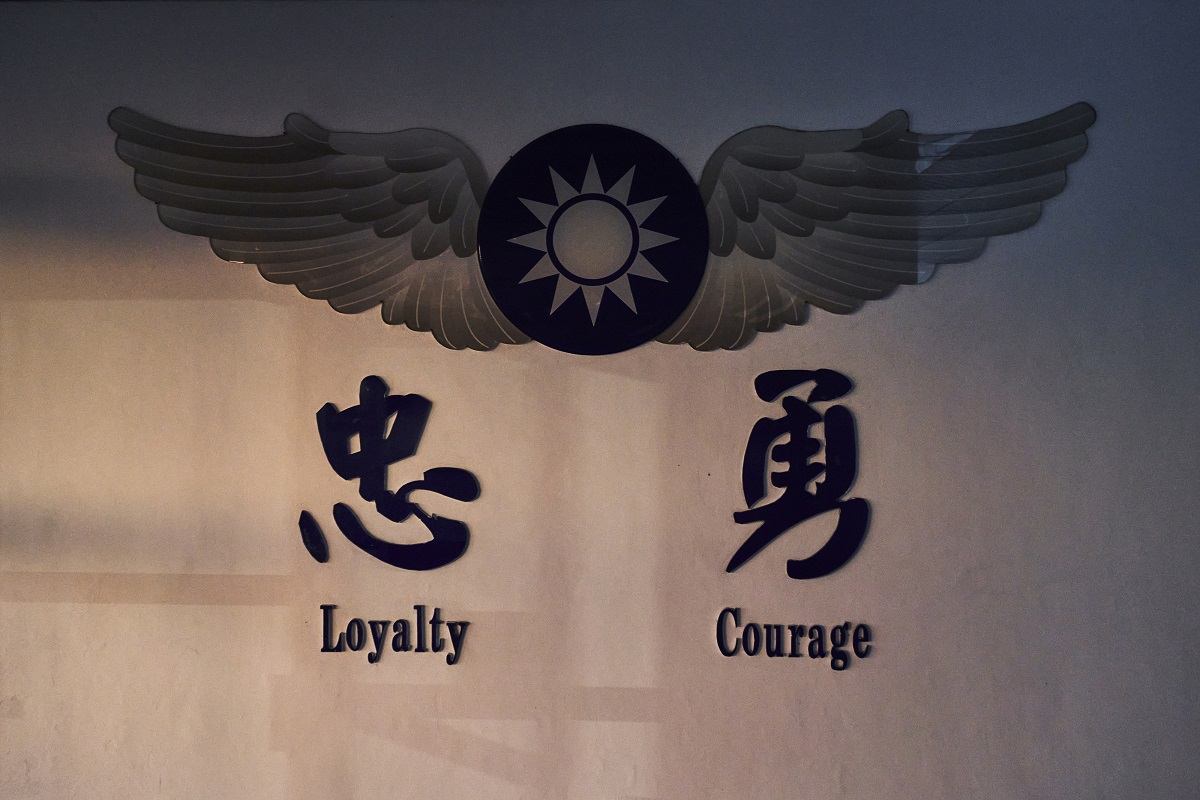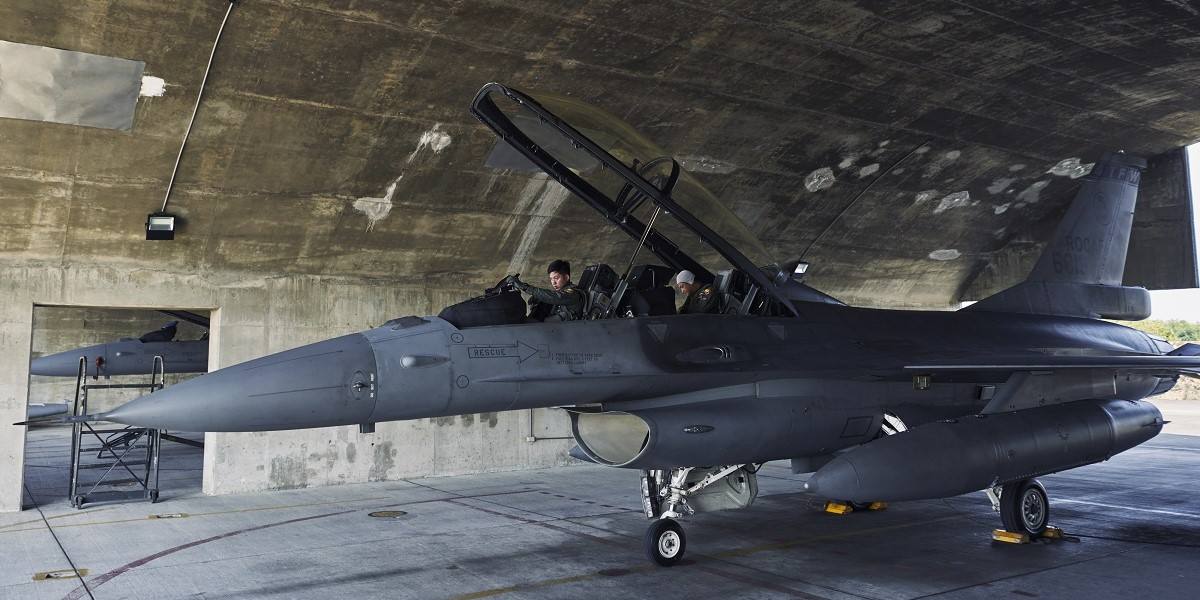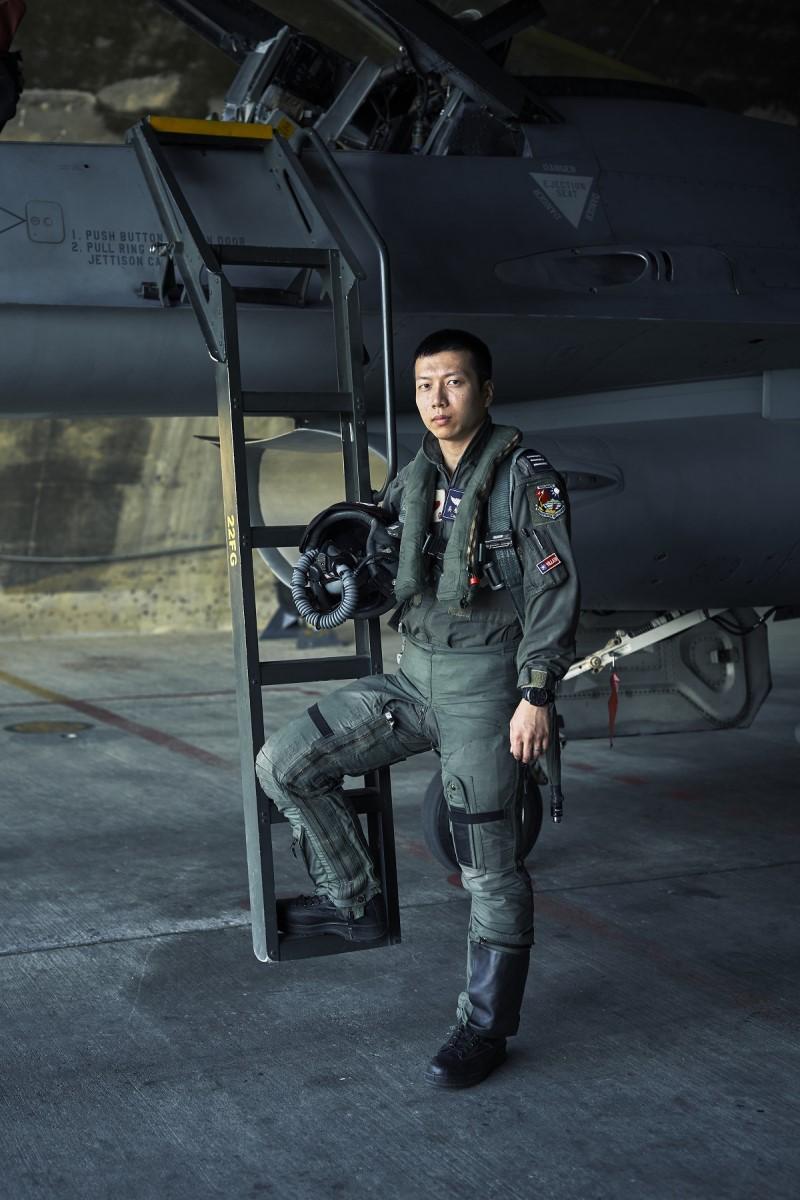
A sign at a Taiwanese Air Force base in Kaohsiung, Taiwan, on Nov. 30, 2022.
12:31 JST, March 1, 2023
CHIAYI, Taiwan – Five years ago, Taiwanese fighter pilot Lt. Col. Hsiao Yi-chiao was ordered to scramble to intercept an incoming Chinese military aircraft. He took off within six minutes, his F-16 jet screaming into the sky above southern Taiwan.
Soon he was following the People’s Liberation Army J-16 fighter jet. Then it suddenly slowed, made a sharp turn and began accelerating toward him.
Unable to communicate with the other plane, Hsiao was alarmed. He had no idea what the PLA pilot was going to do. But the Chinese jet sped past and left, apparently heading back to the Chinese mainland.
“It was pretty provocative,” said Hsiao, who goes by his call sign AJ. “We all think the sky is big, but there’s a real possibility of collision.”
Hsiao, 37, is a member of a small pool of elite fighter pilots in Taiwan whose numbers are in increasingly short supply.
Even as Taiwan awaits the delivery of 66 F-16 fighter jets by the end of 2026, it is facing a personnel shortage that could meaningfully undercut the island democracy’s ability to defend itself if China attacks.
Falling birthrates, the declining appeal of the military and the increasing chances of conflict mean the military has for years struggled to meet its recruitment targets. As a result, the government in December extended mandatory military service from four months to one year.

Members of the Taiwanese Air Force inspect their F-16 jet before taking off for a mission in Chiayi, Taiwan, on Dec. 1, 2022.
Nowhere is the problem more critical than in Taiwan’s elite ranks of fighter pilots, who are dealing with near-daily incursions by Chinese warplanes.
In the years since Hsaio’s close call, he has watched PLA fighter planes fly more frequently and aggressively toward his country as Beijing ramps up threats to realize the Communist Party’s longtime goal of unifying Taiwan and China.
Several of Hsiao’s colleagues have found themselves in dangerous dogfights with Chinese aircraft as pilots from both sides pursue each other, maneuvering for advantage.
Today, Chinese military aircraft regularly cross the median line, an unofficial boundary that both sides respected for years to prevent accidental conflict in the 110-mile-wide Taiwan Strait. The PLA warplanes are a reminder of China’s promises that it will one day annex the island by force if residents do not willingly submit to rule by Beijing.
To prepare for that possibility, Taiwan is adding to its supply of modern fighter jets. When the 66 F-16s made by Lockheed Martin arrive, Taiwan will have more than 200 of the fourth-generation fighter jets, one of the region’s largest fleets.
The highly maneuverable aircraft are able to detect, track and attack targets over great distances and are considered central to resisting a Chinese military invasion.
But at the current rate, Taiwan will not have enough people to fly those planes.
Taiwan will need about 100 new pilots to fly the jets due to arrive in three years’ time, but the Air Force added a net total of only 21 F-16 pilots from 2011 to 2019, according to data from Taiwan’s legislature.
“It will be really difficult to make up that shortage in the next three years,” said Chieh Chung, assistant professor at Tamkang University’s Graduate Institute of International Affairs and Strategic Studies. “The number of our senior pilots will be even more insufficient, and their burden will be even heavier.”
Senior pilots are also tasked with training recruits and intercepting PLA military craft, he said.
Cao Wei-wen, 24, who has just finished basic pilot training with the Air Force, is an anomaly among his friends and family. When fewer young people want to join the military, Cao dreams of becoming an F-16 pilot. As a child he visited air shows at the base in his hometown of Taichung and still remembers the first time he saw the aircraft.
“Two pilots were standing in front of the F-16 fighter jets. They were tall and handsome, but all I noticed was the plane,” he said.
Cao has since graduated from the Air Force Academy and will soon start advanced pilot training.
But his family has come to oppose his career choice as cross-strait relations have worsened following the 2016 election as president of Tsai Ing-wen, whom Beijing sees as supporting Taiwan independence, and the increasing belligerence of Chinese leader Xi Jinping.
During his training over the past year, Cao has also registered a new sense of danger.
“When tensions were less severe, we were hearing about the expelling mainland aircraft about once every two weeks. When things were worse, we were hearing it every two or three days,” he said, referring to broadcasts on the emergency radio channel.
“Hearing it, I was shocked. It makes you feel like this battle of the future may actually happen right here,” he said.
The incursions of Chinese warplanes form a major part of Beijing’s use of “gray zone tactics,” coercive measures just short of conflict that are meant to intimidate and exhaust an opponent.
PLA planes flew into Taiwan’s air defense identification zone at least 1,732 times last year, according to a Washington Post analysis of defense ministry data, up from fewer than 1,000 incursions in 2021 and fewer than 400 in 2020.
These gray zone tactics are not just for intimidation. They are preventing senior pilots like Hsiao, now an instructor, from teaching the next generation of fighter pilots. Hsiao has had to stop training twice in the past two months to wait for the PLA planes to leave before resuming.
To recruit more pilots, the Air Force has lowered standards for admissions, including requirements for eyesight and scores on admissions tests. Officials stress that this will not affect the quality of pilots because the training requirements remain the same.
After basic flight courses, students must take exams that weed out low performers. Cao’s 16-month basic training class began with 45 students, but only 21 students remained at the end.
Students training to fly F-16s must also accumulate at least 250 hours of flying on top of the requirements for basic training. Altogether it can take up to five years to become a fully combat-ready F-16 fighter pilot.
“The admission standards may have been relaxed, but our standards for flight training remain,” said Maj. Chiang Siao-ju, a flight safety officer with the Air Force Academy. “We do everything we can to get them to meet our standards so that we can try to reach the number of pilots needed.”
Air Force officials said they are confident they can fill the gap by paying bonuses to retain pilots nearing retirement age. The Air Force is also recruiting military officers who served in different branches to apply for pilot training, as well as allowing pilots who fly other types of fighter jets to switch to F-16s, according to officials.
Still, even if the number of recruits increases, the number of instructors like Hsiao has remained the same. Hsiao, who must accompany students in the air, says he often hits the maximum 30 hours he can fly in a month.

Portrait of Capt. Wu Sheng-wei of the Taiwanese Air Force with the F-16 jet that he pilots in Chiayi, Taiwan, on Dec. 1, 2022.
Pilots say the intimidation tactics have not affected their resolve. Like many, Capt. Wu Sheng-wei said his interest in becoming a pilot started with the movie “Top Gun.” Growing up near an air base in eastern Taiwan, the 33-year-old often wondered what it would be like to be inside one of those planes.
Today, he is driven by a desire to protect the freedoms he enjoys in Taiwan. “In mainland China, didn’t people protest against being locked down at home? We don’t have problems like that,” he said, referring to the nationwide protests in China in late November over the government’s strict zero-covid rules. “We don’t want to be like them.”
At the Air Force Base in Chiayi, Hsiao recalls feeling the power of the F-16 the first time he flew one more than 11 years ago – his back pressed against the seat as he accelerated to more than 200 mph. “That was a very cool feeling,” he said.
Asked whether he believes he will see war in the Taiwan Strait in his lifetime, Hsiao grows serious. “People said Russia and Ukraine wouldn’t go to war, but they did. We have to be prepared.” What’s important, he said, is showing the willingness to resist.
“We are a sovereign country. We are determined to defend it and not give up easily,” he said. “Why did other countries support Ukraine? It’s because they saw their determination to defend their country.”

AT3 jet pilots from Taiwan’s Air Force return after running missions and trainings at an Air Force base in Kaohsiung, Taiwan, on Nov. 30, 2022.
"News Services" POPULAR ARTICLE
-

American Playwright Jeremy O. Harris Arrested in Japan on Alleged Drug Smuggling
-

Japan’s Nikkei Stock Average as JGB Yields, Yen Rise on Rate-Hike Bets
-

Japan’s Nikkei Stock Average Licks Wounds after Selloff Sparked by BOJ Hike Bets (UPDATE 1)
-

Japanese Bond Yields Zoom, Stocks Slide as Rate Hike Looms
-

Japan’s Nikkei Stock Average Buoyed by Stable Yen; SoftBank’s Slide Caps Gains (UPDATE 1)
JN ACCESS RANKING
-

Keidanren Chairman Yoshinobu Tsutsui Visits Kashiwazaki-Kariwa Nuclear Power Plant; Inspects New Emergency Safety System
-

Imports of Rare Earths from China Facing Delays, May Be Caused by Deterioration of Japan-China Relations
-

University of Tokyo Professor Discusses Japanese Economic Security in Interview Ahead of Forum
-

Japan Pulls out of Vietnam Nuclear Project, Complicating Hanoi’s Power Plans
-

Govt Aims to Expand NISA Program Lineup, Abolish Age Restriction



















